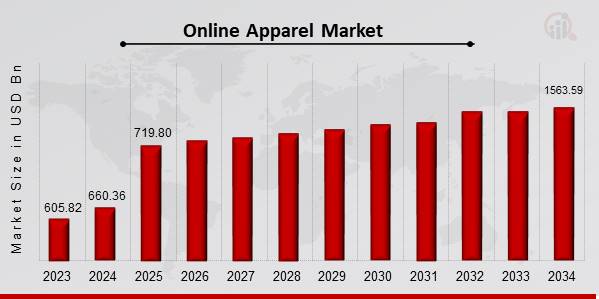Online Apparel Industry Overview
In 2024, Online Apparel Market Size was estimated to be worth USD 660.36 billion. According to projections, the online clothing market is expected to increase at a compound annual growth rate (CAGR) of 9% from USD 719.80 billion in 2025 to USD 1563.59 billion by 2034. Due to factors including convenience of use, a wider range of products, competitive price, and straightforward payment methods, online clothing shopping is growing in popularity. The online apparel market encompasses a broad range of clothing, footwear, and accessories sold through digital platforms. It includes various segments such as casual wear, formal wear, sportswear, and luxury fashion. The market is driven by the widespread penetration of smartphones, high-speed internet connectivity, and the convenience of online transactions. According to recent market research, the global online apparel market is projected to witness substantial growth, with an increasing number of consumers preferring digital platforms over traditional brick-and-mortar stores.

Key Companies in the Online Apparel Market include
- Farfetch Limited
- Alibaba Group Holding Limited
- Walmart Inc.
- Boohoo Group Pic
- H&M Hennes & Mauritz AB
- Nordstrom, Inc.
- ASOS Pic
- Zalando SE
- Inditex (Zara)
“Free Sample Copy” – Access a complimentary copy of our report to explore its content and insights
https://www.marketresearchfuture.com/sample_request/16085
Key Trends in the Online Apparel Market
1. The Rise of Fast Fashion and DTC Brands
Fast fashion has significantly influenced the online apparel market, with brands such as Shein, H&M, and Zara offering affordable and trendy clothing. Direct-to-consumer (DTC) brands are also reshaping the landscape by eliminating intermediaries and providing high-quality products at competitive prices. Companies like Everlane and Gymshark have successfully leveraged digital marketing and social media to build strong customer bases.
2. Sustainable and Ethical Fashion
Sustainability is a major concern in the fashion industry, with consumers increasingly seeking eco-friendly and ethically produced clothing. Brands are incorporating sustainable materials, reducing waste, and adopting ethical manufacturing practices to appeal to environmentally conscious shoppers. Companies such as Patagonia, Reformation, and Eileen Fisher are leading the way in promoting sustainable fashion in the online apparel market.
3. AI and Personalization in Online Shopping
Artificial intelligence (AI) is revolutionizing online apparel shopping by offering personalized recommendations, virtual try-ons, and chatbots for enhanced customer service. AI-powered tools analyze consumer preferences and past purchases to suggest suitable products, improving the overall shopping experience. Augmented reality (AR) features, such as virtual fitting rooms, are gaining popularity, enabling customers to visualize outfits before making a purchase.
4. The Impact of Social Commerce
Social media platforms like Instagram, TikTok, and Facebook have become crucial channels for online apparel retailers. Influencer marketing, live shopping events, and shoppable posts drive sales by creating interactive and engaging shopping experiences. Brands collaborate with influencers to showcase their products, leveraging user-generated content to boost credibility and reach wider audiences.
Growth Drivers of the Online Apparel Market
1. Increasing Internet and Smartphone Penetration
With the widespread adoption of smartphones and internet connectivity, online shopping has become more accessible to consumers across the globe. Mobile commerce (m-commerce) is particularly driving growth, as customers prefer shopping via mobile apps due to their convenience and user-friendly interfaces.
2. The Convenience of E-Commerce Platforms
E-commerce platforms such as Amazon, ASOS, and Shopify-powered stores provide seamless shopping experiences with features like easy payment options, free returns, and fast delivery. The availability of diverse payment methods, including digital wallets and buy-now-pay-later (BNPL) services, has further encouraged online apparel purchases.
3. Competitive Pricing and Discount Strategies
Online retailers frequently offer discounts, promotions, and loyalty programs to attract and retain customers. Flash sales, seasonal discounts, and exclusive online deals contribute to the growing preference for e-commerce over physical stores. Subscription-based models, such as Stitch Fix and Rent the Runway, have also gained traction, offering personalized fashion experiences.
4. Expanding Global Reach and Cross-Border E-Commerce
The online apparel market is not limited to domestic sales; cross-border e-commerce is expanding, enabling consumers to access international brands with ease. Global logistics advancements and partnerships with third-party delivery services have streamlined the shipping process, making it more efficient and affordable for consumers worldwide.
Challenges in the Online Apparel Market
1. High Return Rates
One of the major challenges faced by online apparel retailers is the high return rate due to sizing issues, product misrepresentation, and customer dissatisfaction. Implementing accurate size guides, AI-driven size recommendations, and virtual try-ons can help mitigate this challenge.
2. Counterfeit Products and Fraudulent Sellers
The prevalence of counterfeit products in the online marketplace poses a significant challenge to brands and consumers. Marketplaces must implement stricter regulations, authentication processes, and brand verification systems to ensure product authenticity.
3. Intense Competition and Market Saturation
With numerous brands entering the online apparel market, competition has intensified. Small businesses struggle to differentiate themselves from established brands. Effective digital marketing strategies, niche product offerings, and excellent customer service are crucial for staying competitive.
4. Logistics and Supply Chain Disruptions
Global supply chain disruptions, including raw material shortages, transportation delays, and rising shipping costs, have impacted the online apparel industry. Companies must adopt agile supply chain management practices and invest in local manufacturing to mitigate these risks.
“Proceed to Buy” – Move forward with your purchase and gain instant access to the complete report
https://www.marketresearchfuture.com/checkout?currency=one_user-USD&report_id=16085
Future Prospects of the Online Apparel Market
The future of the online apparel market looks promising, with continuous innovations and evolving consumer behaviors shaping the industry. Some key developments expected to drive growth include:
- Advancements in AI and AR: The integration of AI and AR in online shopping experiences will become more sophisticated, enhancing product discovery and customer engagement.
- Blockchain for Transparency: Blockchain technology will play a crucial role in ensuring supply chain transparency, reducing counterfeit products, and improving consumer trust.
- Growth of Second-Hand and Rental Fashion: The demand for pre-owned and rental fashion is on the rise, driven by sustainability concerns. Platforms like ThredUp and Poshmark are capitalizing on this trend.
- Hyper-Personalization: Retailers will leverage big data and AI to offer highly personalized shopping experiences, increasing customer satisfaction and loyalty.
- Emergence of Metaverse Fashion: Digital fashion and virtual clothing for avatars in the metaverse are gaining attention, opening new revenue streams for brands.
Discover more Research Reports on Consumer-and-Retail Industry, by Market Research Future:
Table-Top Games Market Research Report Forecast Till 2032
Fragrance Market Research Report Forecast Till 2032
Laundry Detergents Market Research Report Forecast Till 2032
Candles Market Research Report Forecast Till 2030
About Market Research Future:
Market Research Future (MRFR) is a global market research company that takes pride in its services, offering a complete and accurate analysis with regard to diverse markets and consumers worldwide. Market Research Future has the distinguished objective of providing optimal quality research and granular research to clients. Our market research studies by products, services, technologies, applications, end users, and market players for global, regional, and country level market segments, enable our clients to see more, know more, and do more, which help answer your most important questions.
Contact Us:
Market Research Future (Part of Wantstats Research and Media Private Limited)
99 Hudson Street, 5Th Floor New York, 10013
United States of America
+1 628 258 0071 (US)
+44 2035 002 764 (UK)
Email: info@marketresearchfuture.com
Website: https://www.marketresearchfuture.com/
https://www.wiseguyreports.com/
Media Contact
Company Name: Market Research Future
Contact Person: Media Relations
Email: Send Email
Country: United States
Website: https://www.marketresearchfuture.com

